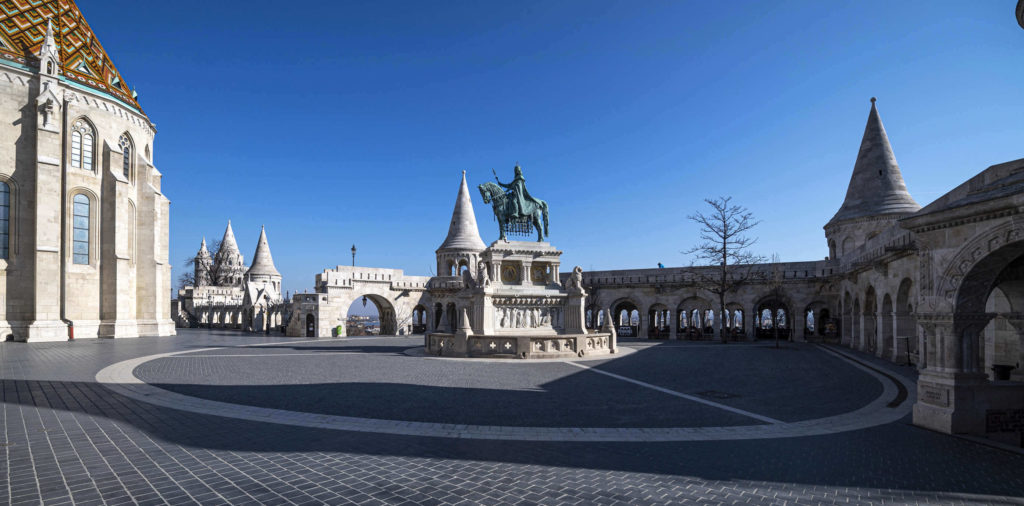12 interesting facts about the Fisherman’s Bastion that you might not have known

The Fisherman’s Bastion is usually one of the most popular tourist attractions in Budapest for foreigners and Hungarians alike, but, of course, it is now almost completely empty due to the coronavirus epidemic. It might be a while until you can travel there to see it personally, so Szeretlek Magyarország found 12 exciting facts about the Fisherman’s Bastion that not many of us have known before.
- The origin of the Fisherman’s Bastion
In its current form, the Fisherman’s Bastion was one of the defensive sections of the city wall of Buda. It has been part of the medieval city wall since the 15th century. Some people think its name comes from the craft of the inhabitants of ‘Víziváros’ (‘Watertown’) or ‘Halászváros’ (‘Fishermen’s town’) located below it, but according to another source, its name comes from the fact that the Fishermen’s Guild of Buda protected it. The Fisherman’s Bastion is a newer iteration of the defence section of the city wall of Buda, and it was built on the foundation of the previous bastion.
- Was there a secret path?
According to legends, there was a secret path in this part of the castle, which was used by fishermen to get to the fish market in Buda. Several sources suggest that László Hunyadi tried to escape from the Castle through this secret road, and according to another story, in 1541, the besieging Viennese army tried to get into the Castle using the very same secret path.

- Transformation in the Baroque era
After the recapture of Buda and the suppression of the Rákóczi uprising, the military administration of the Habsburgs modernised the bastion at the beginning of the 18th century. The walls were altered so that each section could protect the next with its own artillery pieces.
- From military function to tourist attraction
Once it was no longer needed for its defensive function after 1874, several plans were made to make the former, rather plain, wall section into something more spectacular so that the bastion could continue to exist as a decorative element.
- Frigyes Schulek was considered a fool because of his vision
“Great goals and difficult situations move his creativity. When, at the meeting of the building committee of the coronation church in Buda on December 2, 1875, President Baron Augusz called for a proposal to restore the church and Schulek presented his plan, a long, awkward silence ensued, when finally the president said: ‘Does the professor think we are crazy? It is just an aberration of an overheated young fantasy,’” an article in 1911 wrote about Frigyes Schulek’s plans. “Twenty-five years later, the bold designer reached his goal. The church was restored according to his plan, and the Fisherman’s Bastion was completed.”
- There was originally not enough money for the makeover
People were already at the planning stage when they found out that the construction would cost too much. Frigyes Schulek – the one who rebuilt the ‘Nagyboldogasszony’ Church in such a way that the building could once again be a Gothic wonder living in the heyday of Mátyás – argued that a worthy environment should be created for the Mátyás Church, and it must be made into a tourist attraction. The initial budget significantly grew, so the construction works had to be postponed.

- The structure became one huge block
The area was transformed to include the still intact sections of the original bastion wall. The Fisherman’s Bastion became one long uninterrupted edifice, which is one of the most characteristic sights of Buda. Schulek’s work was not fully realized, however. He dreamed of an even more grandiose work.
- Construction was also exciting for archaeologists
During the reconstruction of the Fisherman’s Bastion, many tombstones were unearthed, and archaeologists even found a chapel connected to the burial place of ‘Nagyboldogasszony’.
- The lions of the Romanesque church
When the Romanesque church was excavated during the earthworks of the reconstruction of the Fisherman’s Bastion, the original stone lion relief from the church was placed over the similarly just-reconstructed Jesuit stairs by Frigyes Schulek.
- The number of towers is important
They symbolise the seven chieftains of the original conquering tribes in Hungarian history. Both ‘Álmos’ and ‘Előd’ appear as statues at the main tower. Although the Fisherman’s Bastion was completed after the Millennium celebrations and the festive year of 1896, it is connected to them through these symbols and figures evoking the Hungarian Conquest.
- Unique columns
Each carved column head of the column pairs of the Fisherman’s Bastion was designed by Frigyes Schulek in such a way that their pattern was as varied as possible, without the same motif being repeated. People, therefore, say that there are no 3 pairs of identical columns in the building.
- One of the statues was made to the image of Woody Harrelson
In 2015, a photo – taken by a tourist at the Fisherman’s Bastion in Budapest – circulated all major social platforms about how one of the statues looks exactly like Woody Harrelson. For months, people on Reddit, Imgur, and Facebook joked that the actor must be a time traveller. So, whenever you go visit the Fisherman’s Bastion, you will always find someone photographing that statue.
Source: Szeretlekmagyarország.hu









